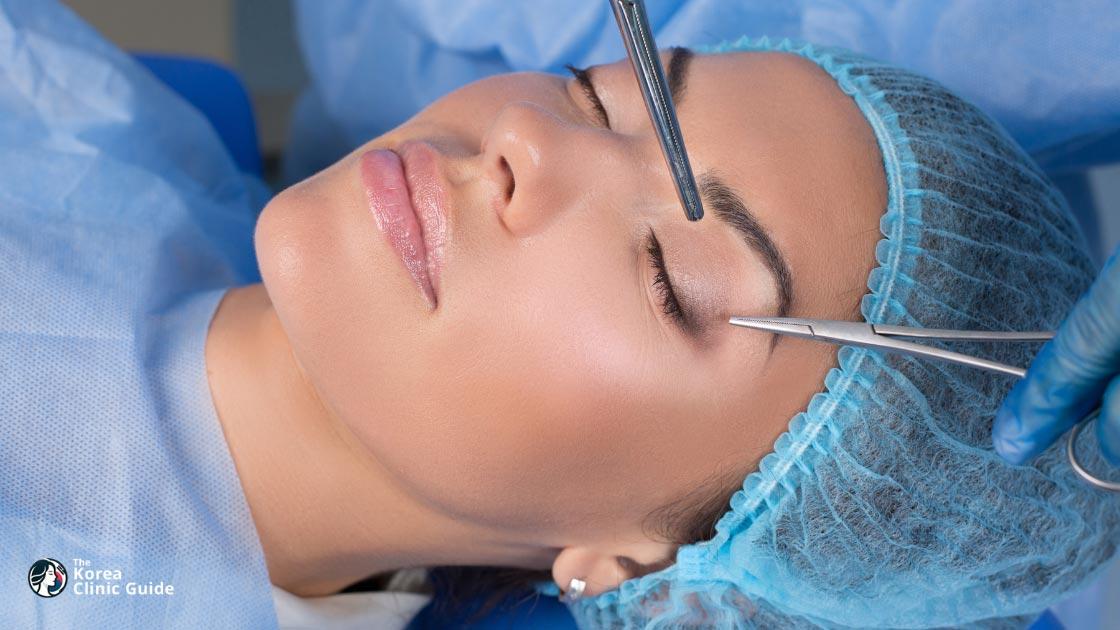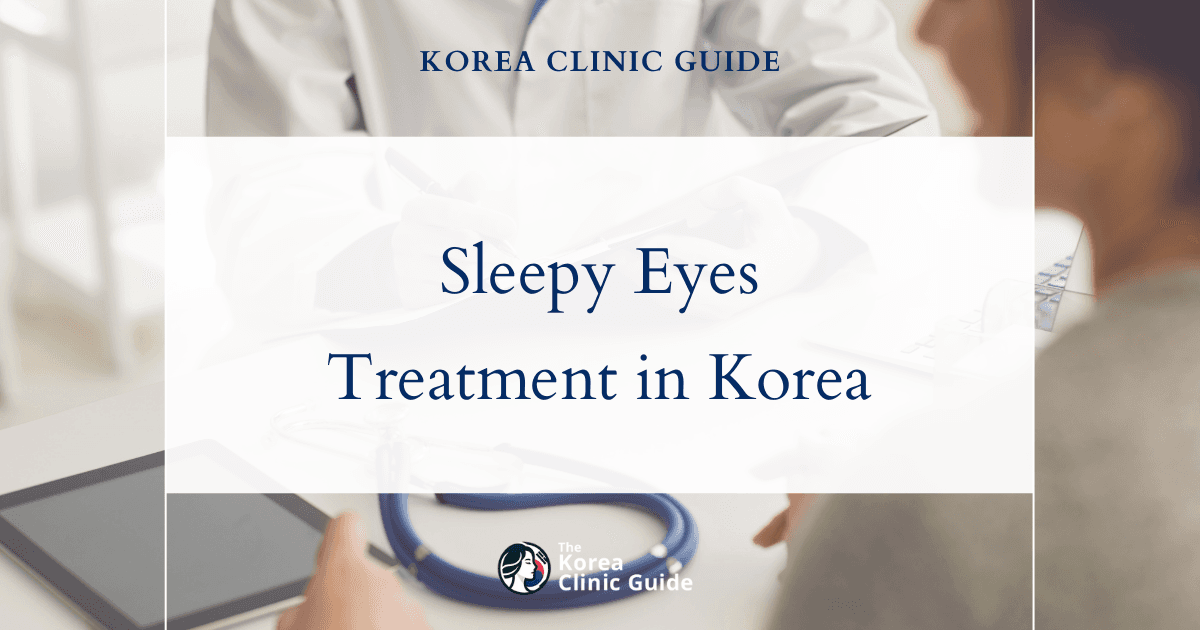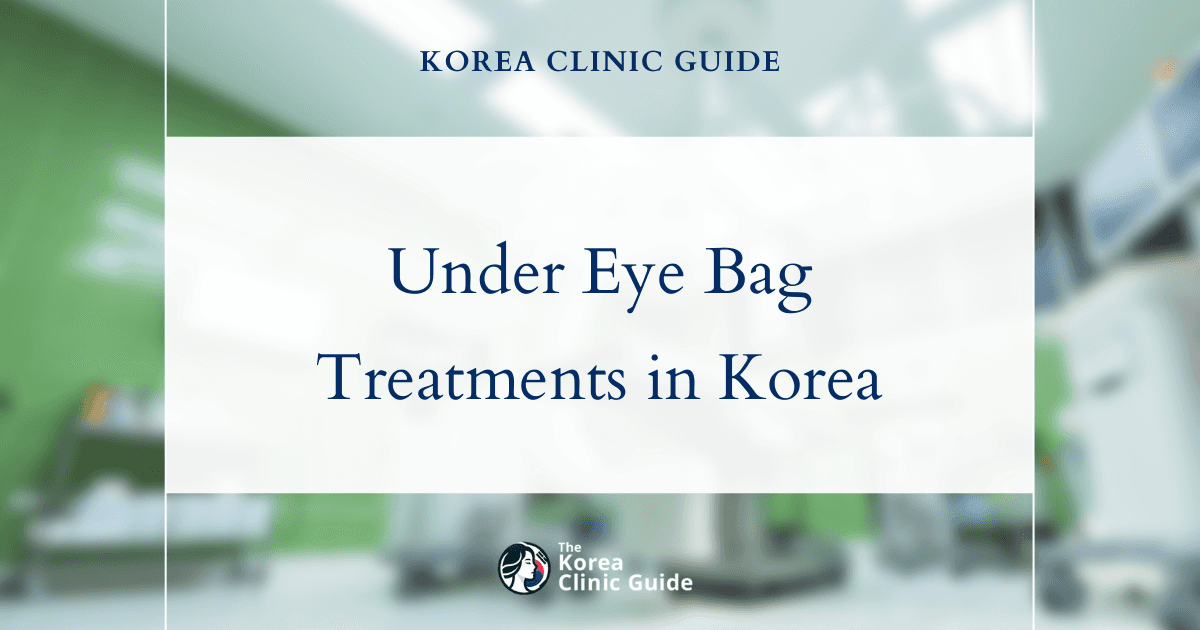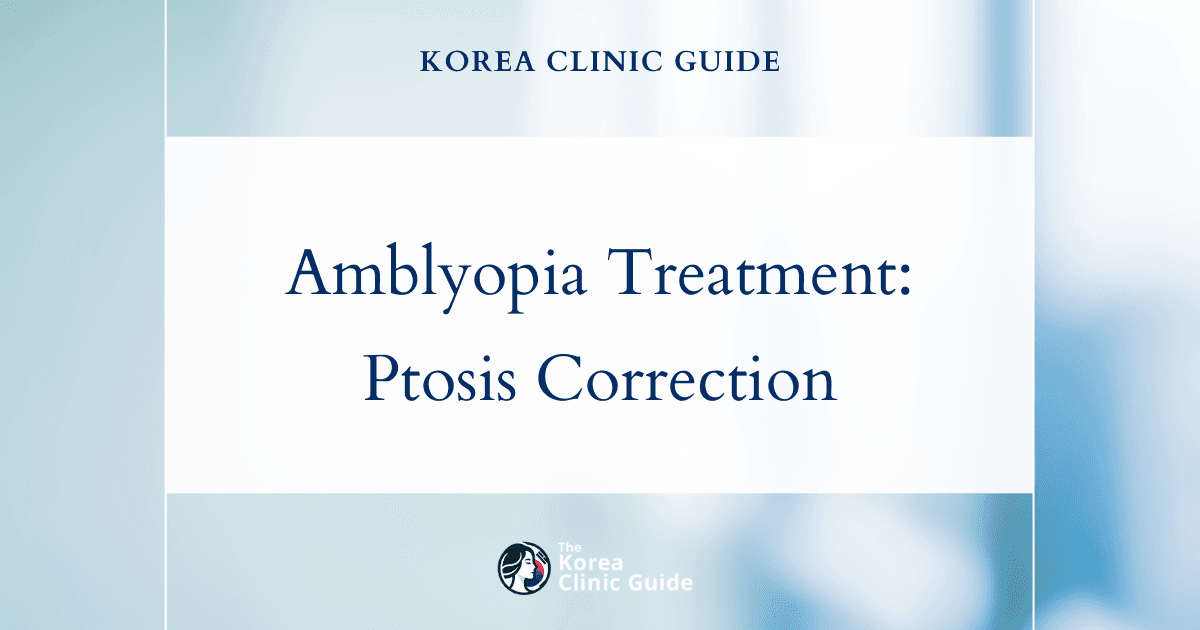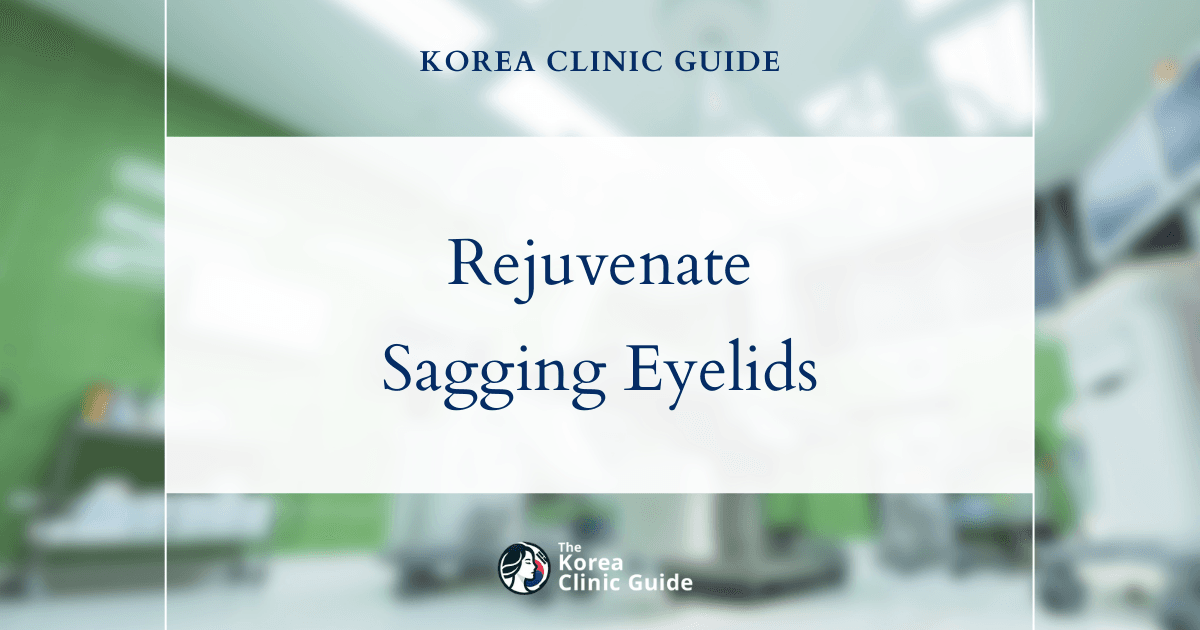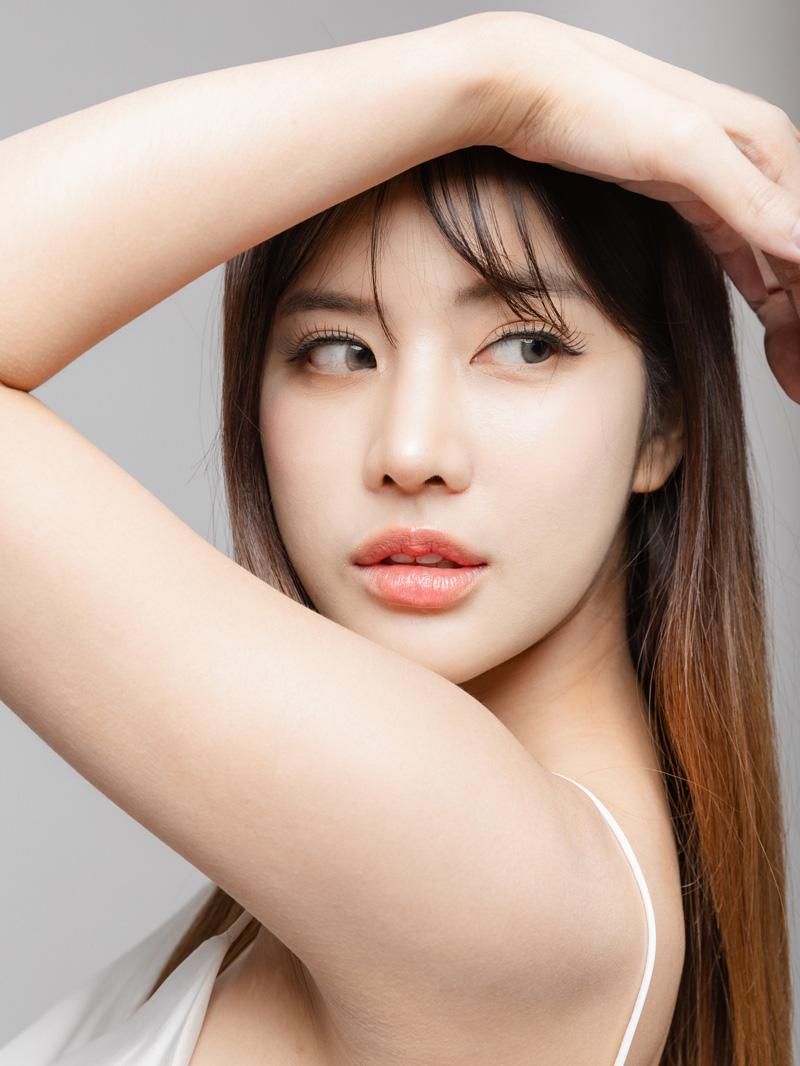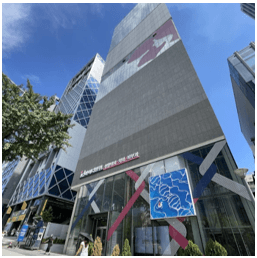Medical Tourism Blog
Eyelid Fat Grafting in Korea | Best Clinics, Costs, Procedure Types & More
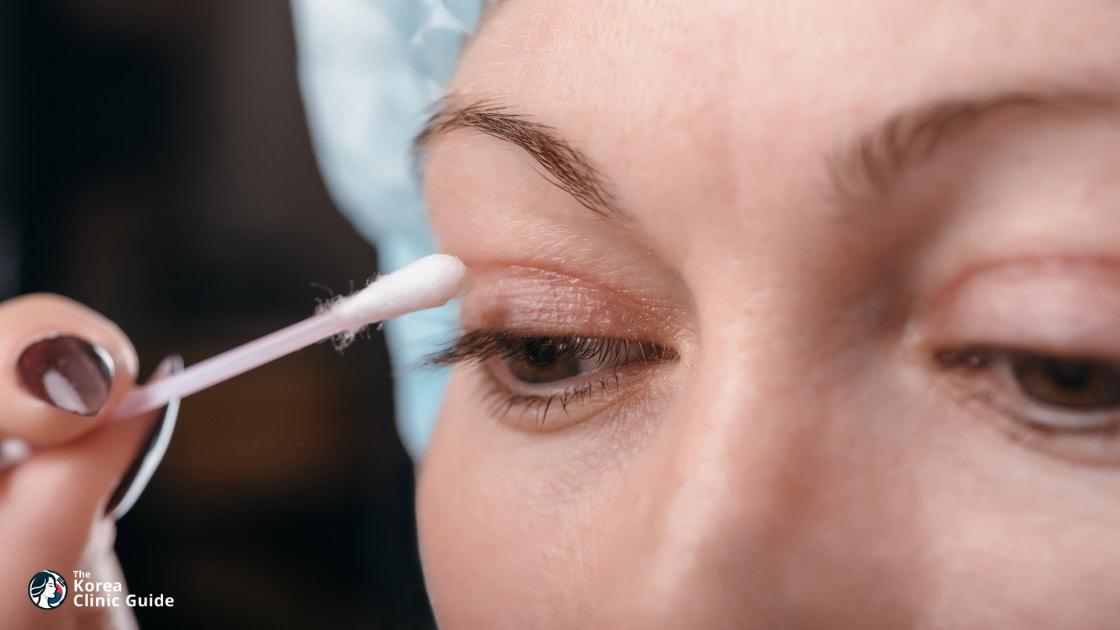
Table of contents
- What Is Eyelid Fat Grafting?
- Best Clinics in Korea for Eyelid Fat Grafting
- Getting Eyelid Fat Grafting in Korea
- Cost of Eyelid Fat Grafting in Korea
- Alternatives to Eyelid Fat Grafting
- Conclusion
Considering treatment in Korea? Everything you need to know e.g. — how to avoid scams, visas, interpreters, recovery tips — in our Medical Tourism Master Guide. Plan with confidence in minutes, not weeks!
Ever wished you could turn back the clock and achieve a rejuvenated appearance without the use of synthetic fillers? Welcome to the world of eyelid fat grafting, a burgeoning cosmetic technique in South Korea that's redefining youthful allure by using a patient's own fat to enhance the eye area naturally. This comprehensive guide delves into what makes this procedure a sought-after solution for those looking to address aging signs and highlights South Korea as a leading destination for top-tier eyelid transformations.
What Is Eyelid Fat Grafting?
Eyelid fat grafting, also known as autologous fat transfer or fat injection, is a specialized cosmetic procedure aimed at rejuvenating the eye area by redistributing fat from one part of the body to the eyelids. This technique is employed to address volume loss and hollowness that can occur due to aging, weight loss, or genetic predisposition.
The procedure involves several steps:
Step 1: Harvesting the Fat
The process begins with the harvesting of fat from a donor site on the patient’s body, such as the abdomen, thighs, or flanks. This is typically done using liposuction, a minimally invasive technique that employs a thin tube (cannula) to extract fat cells. Local anesthesia is administered to ensure patient comfort during this step.
Step 2: Purifying the Fat
Once the fat is harvested, it undergoes a purification process to ensure viability and longevity of the fat cells post-transfer. The collected fat is centrifuged or filtered to remove blood, oil, and other unwanted components. Only the healthiest fat cells are retained for the grafting procedure.
Step 3: Injecting the Fat
The purified fat is meticulously injected into the eyelid area using fine cannulas or needles. The goal is to achieve a smooth, natural contour and restore youthful fullness. The surgeon strategically injects small amounts of fat into target areas to ensure even distribution and prevent lumpiness. Multiple layers may be filled to create a seamless appearance.
Recovery and Results
Post-procedure, patients usually experience mild swelling and bruising, which typically subsides within one to two weeks. The transplanted fat cells establish their own blood supply and integrate into the surrounding tissues, resulting in a more permanent fix compared to synthetic fillers. The results are most noticeable after a few months, as the swelling completely resolves and the fat cells stabilize.
Advantages and Applications
Eyelid fat grafting offers several benefits, including:
- Natural Results: Because the procedure uses the patient’s own fat, the risk of allergic reactions is minimized, and the results appear more natural.
- Longevity: While some of the transferred fat may be reabsorbed by the body, the majority of it remains, providing a longer-lasting solution than temporary dermal fillers.
- Versatility: This technique is not only useful for the lower eyelids but can also address volume loss in the upper eyelids and tear troughs.
Ideal Candidates
Ideal candidates for eyelid fat grafting are individuals experiencing:
- Hollowness or sunken appearance around the eyes
- Dark circles related to volume loss
- Fine lines and wrinkles around the eyes
- Overall eyelid aging that would benefit from volume restoration
This procedure is particularly popular among those seeking a more natural option for eyelid rejuvenation without the use of synthetic fillers or invasive surgery.
Who is Eyelid Fat Grafting for?
- Individuals with Tired-Looking Eyes: Eyelid fat grafting can rejuvenate tired-looking eyes, making them appear more youthful and energetic.
- People with Under-Eye Bags: This procedure can help reduce the appearance of puffy under-eye bags.
- Those with Dark Circles: Eyelid fat grafting can minimize dark circles under the eyes.
- Individuals with Sunken Hollows: It is effective in plumping up sunken and hollow areas beneath the eyes and cheeks.
- Aging Individuals: Those looking to reduce the effects of aging such as sagging skin and wrinkles around the eyes can benefit.
- Non-Smokers: People who do not smoke, as smoking can affect the healing process and the success of the fat transfer.
- Individuals with Sufficient Body Fat: You need to have enough body fat for the procedure, hence, extremely thin individuals or those who exercise intensely may not be suitable candidates.
- Non-Pregnant Individuals: Pregnant women may need to opt for other types of dermal fillers instead.
Those considering this procedure should have a thorough consultation with their healthcare provider to determine suitability based on individual conditions and goals.
Best Clinics in Korea for Eyelid Fat Grafting
Listed below are the best clinics in Korea for eyelid fat grafting:
| Clinic Name | Key Features | Special Techniques |
|---|---|---|
| THEPLUS Plastic Surgery | Nestled on Garosu-gil in Gangnam, Seoul, THE PLUS Plastic Surgery is a world-class, four-floor center designed to deliver a seamless journey from consultation through surgery and post-operative skincare. Led by internationally recognized director surgeons Dr. Jeong Jae Yong and Dr. Kim Taek Kyun, the clinic is renowned for rhinoplasty, revision rhinoplasty, and facial contouring, with its medical team actively publishing in journals and textbooks, presenting at global symposiums, and elevating industry standards through ongoing education—even during challenging periods like the COVID-19 pandemic. With safety and patient satisfaction at its core, a team of board-certified surgeons with over a decade of experience, and a philosophy grounded in meticulous technique and personalized communication, THE PLUS embodies the pinnacle of contemporary aesthetic surgery in Korea. |
Why THE PLUS Plastic Surgery stands out for Eyelid Fat Grafting
- Elite leadership and credentials: Dr. Jeong is the President of the Korean Society of Plastic Surgeons and a frequent international speaker; Dr. Kim is a board-certified global society member, award-winning researcher in 3D implants, and a leading expert in rhinoplasty and facial contouring who runs annual educational sessions; Dr. Lee is a board-certified surgeon with top-tier experience including Seoul National University Hospital and active roles in major societies.
- Eye and periorbital expertise: The clinic’s portfolio includes double eyelid surgery, ptosis correction, canthoplasty, and blepharoplasty, alongside face fat grafting—an ideal foundation for precise eyelid fat grafting that restores delicate periorbital volume with natural-looking results.
- Harmony-first aesthetics: Dr. Kim’s belief in balanced facial harmony and Dr. Jeong’s ethos of combining function and beauty guide planning and execution to enhance existing features rather than overcorrect—key to elegant eyelid fat grafting outcomes.
- Research-driven, continuously updated techniques: THE PLUS surgeons regularly contribute to scholarly books and journals, participate in domestic and international symposiums, and lead educational sessions and webinars, ensuring methods reflect the latest advances in cosmetic surgery.
- Proven safety culture and experience: A highly experienced team with more than a decade in practice, active membership in leading medical societies (including the American Society of Plastic Surgeons), and global invitations for presentations and live surgeries underscore rigorous standards.
- Comprehensive, seamless care: A purpose-built four-floor facility supports every step—consultation, surgery, and post-operative skincare—allowing meticulous follow-up and refined aftercare crucial for periorbital healing.
- Natural, long-lasting philosophy: Dr. Lee’s approach to achieving natural and enduring results, combined with the clinic’s emphasis on nuanced facial contouring, aligns with the subtlety required for successful eyelid fat grafting.
- Trusted for complex facial work: Excellence in rhinoplasty, revision cases, and facial bone surgery speaks to sophisticated anatomical understanding and fine surgical control—skills that translate to the precision needed around the eyelids.
You can check out their website here: THEPLUS Plastic Surgery Website{data-slug="theplus-plastic-surgery" data-position="1"} | - Eyelid fat grafting; face fat grafting; rhinoplasty; revision rhinoplasty; facial contouring | | Made Young Plastic Surgery Website{data-slug="made-young-plastic-surgery" data-position="2"} | Made Young Plastic Surgery Clinic in Gangnam is a premium center for facial rejuvenation and anti-aging, with standout expertise in eyelid fat grafting. Led by Dr. Park Byung-Chan—who has devoted 15 years exclusively to eye surgery—the clinic is known for delivering natural, beautiful eye results, often visible even on the day of surgery. From consultation through surgery, patients receive genuine, patient-centered care, with meticulous customization of incision lines, double eyelid height, eyelid thickness, and overall image to achieve the most harmonious and natural eye shape. Every procedure begins with a direct consultation and diagnosis by the medical team, leveraging proven skills and extensive clinical experience.
MadeYoung’s verified medical team averages over 15 years of experience and operates under a comprehensive safety system that includes full-time board-certified anesthesiologists, 1:1 dedicated monitoring, a cross-check response protocol, and full CCTV coverage for transparency. A separate, dedicated aftercare center provides complete and systematic postoperative care. The clinic’s commitment to excellence is recognized with the 2022 Korea No.1 Award and the 2022 Korea Customer Satisfaction 1st Place, alongside selection as an Outstanding Member of the Korean Society of Plastic and Reconstructive Surgeons and certification by the Minimally Invasive Aesthetic Surgery Society. With safety as its guiding principle and an approach that balances timeless beauty ideals with cutting-edge techniques, MadeYoung offers a refined, reliable destination for eyelid fat grafting in Korea.
You can check out their website here: Made Young Plastic Surgery Website{data-slug="made-young-plastic-surgery" data-position="2"} | - Eyelid fat grafting | | Banobagi Plastic Surgery Website{data-slug="banobagi-plastic-surgery" data-position="3"} | Banobagi Plastic Surgery is a representative and widely trusted plastic surgery brand in Korea, founded in February 2000 by four specialists from Seoul National University Hospital with an artisan spirit for beauty. Guided by a warm, patient-centered medical philosophy and recognized for excellent surgical skills, Banobagi has grown into a leading plastic surgery space—especially after the full-building renovation on October 7, 2008, which created a modern, advanced medical environment. With years of know-how and a commitment to being a hospital loved by patients, recommended by people, and recognized for reliability, Banobagi offers comprehensive, customized care supported by professional equipment and ethical practices.
- Founded by Seoul National University Hospital–trained plastic surgery specialists; 20+ years of accumulated know-how that is ideal for delicate procedures like eyelid fat grafting
- Dedicated eye surgery center within a large, specialty-focused system for eyes, nose, facial contouring, wrinkle surgery, and more—enabling focused expertise for periorbital rejuvenation
- 1:1 customized treatments to tailor fat placement and overall harmony around the eyes to each patient’s anatomy and aesthetic goals
- Ethical medical philosophy that strictly avoids unnecessary or excessive surgeries, supporting natural-looking results and patient safety in eyelid fat grafting
- Modern, advanced medical environment following the 2008 full-building renovation, reinforcing safety, precision, and patient comfort
- Mammoth-sized clinic with a 6-story main building (total floor area of 600 pyeong) and a 5-story annex, providing integrated care and professional equipment in each field
- A reliable and famous brand in Korea, recognized and loved by patients, making it a trusted choice for sensitive eye-area procedures like eyelid fat grafting
- Warm, patient-first care that treats each individual like family, enhancing consultation quality, follow-up, and long-term satisfaction
Find more about this clinic here: Banobagi Plastic Surgery Website{data-slug="banobagi-plastic-surgery" data-position="3"} | - Eyelid fat grafting; periorbital rejuvenation |
THEPLUS Plastic Surgery
Nestled on Garosu-gil in Gangnam, Seoul, THE PLUS Plastic Surgery is a world-class, four-floor center designed to deliver a seamless journey from consultation through surgery and post-operative skincare. Led by internationally recognized director surgeons Dr. Jeong Jae Yong and Dr. Kim Taek Kyun, the clinic is renowned for rhinoplasty, revision rhinoplasty, and facial contouring, with its medical team actively publishing in journals and textbooks, presenting at global symposiums, and elevating industry standards through ongoing education—even during challenging periods like the COVID-19 pandemic. With safety and patient satisfaction at its core, a team of board-certified surgeons with over a decade of experience, and a philosophy grounded in meticulous technique and personalized communication, THE PLUS embodies the pinnacle of contemporary aesthetic surgery in Korea.
Why THE PLUS Plastic Surgery stands out for Eyelid Fat Grafting
- Elite leadership and credentials: Dr. Jeong is the President of the Korean Society of Plastic Surgeons and a frequent international speaker; Dr. Kim is a board-certified global society member, award-winning researcher in 3D implants, and a leading expert in rhinoplasty and facial contouring who runs annual educational sessions; Dr. Lee is a board-certified surgeon with top-tier experience including Seoul National University Hospital and active roles in major societies.
- Eye and periorbital expertise: The clinic’s portfolio includes double eyelid surgery, ptosis correction, canthoplasty, and blepharoplasty, alongside face fat grafting—an ideal foundation for precise eyelid fat grafting that restores delicate periorbital volume with natural-looking results.
- Harmony-first aesthetics: Dr. Kim’s belief in balanced facial harmony and Dr. Jeong’s ethos of combining function and beauty guide planning and execution to enhance existing features rather than overcorrect—key to elegant eyelid fat grafting outcomes.
- Research-driven, continuously updated techniques: THE PLUS surgeons regularly contribute to scholarly books and journals, participate in domestic and international symposiums, and lead educational sessions and webinars, ensuring methods reflect the latest advances in cosmetic surgery.
- Proven safety culture and experience: A highly experienced team with more than a decade in practice, active membership in leading medical societies (including the American Society of Plastic Surgeons), and global invitations for presentations and live surgeries underscore rigorous standards.
- Comprehensive, seamless care: A purpose-built four-floor facility supports every step—consultation, surgery, and post-operative skincare—allowing meticulous follow-up and refined aftercare crucial for periorbital healing.
- Natural, long-lasting philosophy: Dr. Lee’s approach to achieving natural and enduring results, combined with the clinic’s emphasis on nuanced facial contouring, aligns with the subtlety required for successful eyelid fat grafting.
- Trusted for complex facial work: Excellence in rhinoplasty, revision cases, and facial bone surgery speaks to sophisticated anatomical understanding and fine surgical control—skills that translate to the precision needed around the eyelids.
You can check out their website here: THEPLUS Plastic Surgery Website
Made Young Plastic Surgery
Made Young Plastic Surgery Clinic in Gangnam is a premium center for facial rejuvenation and anti-aging, with standout expertise in eyelid fat grafting. Led by Dr. Park Byung-Chan—who has devoted 15 years exclusively to eye surgery—the clinic is known for delivering natural, beautiful eye results, often visible even on the day of surgery. From consultation through surgery, patients receive genuine, patient-centered care, with meticulous customization of incision lines, double eyelid height, eyelid thickness, and overall image to achieve the most harmonious and natural eye shape. Every procedure begins with a direct consultation and diagnosis by the medical team, leveraging proven skills and extensive clinical experience.
MadeYoung’s verified medical team averages over 15 years of experience and operates under a comprehensive safety system that includes full-time board-certified anesthesiologists, 1:1 dedicated monitoring, a cross-check response protocol, and full CCTV coverage for transparency. A separate, dedicated aftercare center provides complete and systematic postoperative care. The clinic’s commitment to excellence is recognized with the 2022 Korea No.1 Award and the 2022 Korea Customer Satisfaction 1st Place, alongside selection as an Outstanding Member of the Korean Society of Plastic and Reconstructive Surgeons and certification by the Minimally Invasive Aesthetic Surgery Society. With safety as its guiding principle and an approach that balances timeless beauty ideals with cutting-edge techniques, MadeYoung offers a refined, reliable destination for eyelid fat grafting in Korea.
You can check out their website here: Made Young Plastic Surgery Website
Banobagi Plastic Surgery
Banobagi Plastic Surgery is a representative and widely trusted plastic surgery brand in Korea, founded in February 2000 by four specialists from Seoul National University Hospital with an artisan spirit for beauty. Guided by a warm, patient-centered medical philosophy and recognized for excellent surgical skills, Banobagi has grown into a leading plastic surgery space—especially after the full-building renovation on October 7, 2008, which created a modern, advanced medical environment. With years of know-how and a commitment to being a hospital loved by patients, recommended by people, and recognized for reliability, Banobagi offers comprehensive, customized care supported by professional equipment and ethical practices.
- Founded by Seoul National University Hospital–trained plastic surgery specialists; 20+ years of accumulated know-how that is ideal for delicate procedures like eyelid fat grafting
- Dedicated eye surgery center within a large, specialty-focused system for eyes, nose, facial contouring, wrinkle surgery, and more—enabling focused expertise for periorbital rejuvenation
- 1:1 customized treatments to tailor fat placement and overall harmony around the eyes to each patient’s anatomy and aesthetic goals
- Ethical medical philosophy that strictly avoids unnecessary or excessive surgeries, supporting natural-looking results and patient safety in eyelid fat grafting
- Modern, advanced medical environment following the 2008 full-building renovation, reinforcing safety, precision, and patient comfort
- Mammoth-sized clinic with a 6-story main building (total floor area of 600 pyeong) and a 5-story annex, providing integrated care and professional equipment in each field
- A reliable and famous brand in Korea, recognized and loved by patients, making it a trusted choice for sensitive eye-area procedures like eyelid fat grafting
- Warm, patient-first care that treats each individual like family, enhancing consultation quality, follow-up, and long-term satisfaction
Find more about this clinic here: Banobagi Plastic Surgery Website
Getting Eyelid Fat Grafting in Korea
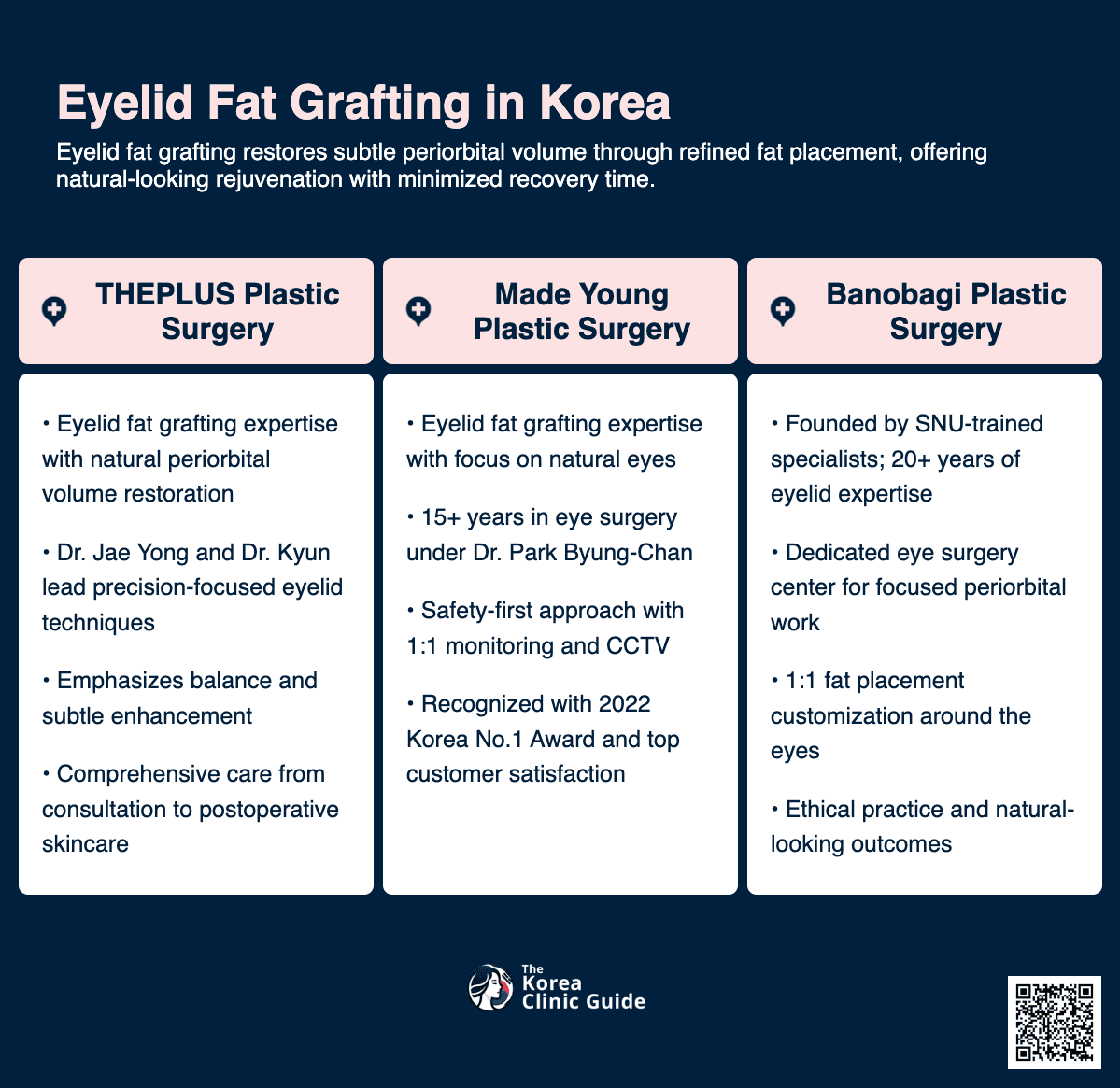
Eyelid Fat Grafting, also known as fat transfer or lipofilling, is a cosmetic surgical procedure which involves harvesting fat from one area of the body and injecting it into the upper or lower eyelids. This technique aims to rejuvenate the eyelid area by adding volume, smoothing out wrinkles, and addressing hollow or sunken areas. In Korea, this procedure is highly refined, incorporating advanced methods and technologies to ensure optimal results and patient satisfaction.
Initial Consultation
The process begins with an initial consultation with a board-certified plastic surgeon. During this meeting, the surgeon evaluates the patient's medical history, discusses aesthetic goals, and conducts a physical examination. Photographs may be taken for reference. Based on this detailed assessment, a personalized treatment plan is created.
Fat Harvesting
The next step involves harvesting fat from a donor site on the patient's body. Common areas for fat extraction include the abdomen, thighs, or flanks. The surgeon employs a minimally invasive liposuction technique to ensure that the extracted fat cells remain viable. Local anesthesia or sedation is typically used to minimize discomfort during this process. The harvested fat is then subjected to a purification process, where it is cleaned and concentrated to enhance the survival rate of the fat cells.
Preparation and Injection
Once purified, the fat is meticulously prepared for injection. The surgeon carefully maps out the targeted eyelid areas, taking into account the patient's anatomy and desired outcomes. Using a fine cannula or needle, the prepared fat is injected into the upper or lower eyelids. Multiple small injections are usually required to achieve a smooth and natural appearance. This step demands significant skill and precision to ensure even distribution and to avoid complications.
Recovery and Aftercare
Post-procedure, patients can expect some swelling, bruising, and minor discomfort in both the donor and injection sites. These symptoms typically subside within a week or two. The surgeon will provide detailed aftercare instructions, which may include medications to manage pain, guidelines on how to care for the treated areas, and recommendations for follow-up appointments.
Patients are generally advised to avoid strenuous activities for a few weeks to allow for proper healing. Cold compresses and elevating the head during sleep can help minimize swelling. The final results of eyelid fat grafting become evident once the swelling has completely subsided, usually within three to six months.
Expertise in Korea
Korea is globally renowned for its excellence in cosmetic surgery, and many clinics boast state-of-the-art facilities and experienced surgeons specializing in eyelid procedures. The country's focus on advanced techniques and patient-centered care makes it a popular destination for those seeking high-quality eyelid fat grafting.
The combination of expert surgical skills, cutting-edge technology, and an emphasis on natural, aesthetically pleasing results ensures that patients receive outstanding care and achieve their desired look.
Cost of Eyelid Fat Grafting in Korea
Eyelid fat grafting, a popular cosmetic procedure aimed at rejuvenating the appearance of the eyes, involves transferring fat from one part of the body to the eyelids. Korea has emerged as a leading destination for this procedure due to its advanced medical technologies, high standards of care, and experienced surgeons. One of the key factors driving international patients to Korea for eyelid fat grafting is the competitive pricing compared to other countries.
In Korea, the cost of eyelid fat grafting typically ranges between $2,000 and $4,000. This price includes consultation fees, the surgery itself, post-operative care, and sometimes even accommodation for international patients. The cost can vary depending on the clinic, the surgeon’s experience, and the complexity of the procedure.
When compared to the United States, patients can expect to pay significantly more for eyelid fat grafting. In the U.S., the average cost ranges from $6,000 to $10,000. This higher price is attributed to factors such as higher operational costs, surgeon fees, and additional expenses like anesthesia and post-operative appointments.
In Europe, the cost of eyelid fat grafting also tends to be higher than in Korea, although it can vary widely between countries. For instance, in the United Kingdom, the procedure can cost anywhere from £5,000 to £8,000 (approximately $6,500 to $10,500 USD). Similarly, in Germany and France, prices are generally consistent with those in the UK, hovering around €4,500 to €9,000 ($5,000 to $10,000 USD).
Australia exhibits similar cost trends to those in the U.S. and Europe. Patients in Australia can expect to pay between AUD 7,000 to AUD 12,000, roughly equivalent to $5,000 to $8,500 USD.
In contrast, countries like Thailand and India offer more budget-friendly options for eyelid fat grafting, with costs ranging between $1,000 and $3,000. These lower prices, however, might come with varying levels of medical standards and expertise, which are crucial factors to consider when selecting a destination for cosmetic surgery.
Korea's appeal as an eyelid fat grafting destination is not solely based on cost. The country is renowned for its state-of-the-art medical facilities, highly skilled surgeons, and rigorous clinical protocols, making it an attractive option for those seeking high-quality yet affordable cosmetic enhancements.
Alternatives to Eyelid Fat Grafting
If you're considering eyelid fat grafting but want to explore other options, here are three suitable alternatives that can help you achieve a more youthful and rejuvenated look:
Dermal Fillers
Dermal fillers are an excellent non-surgical alternative to eyelid fat grafting. Unlike fat grafting, which uses fat cells from your body, most dermal fillers are lab-made substances ready for immediate use. These fillers are injected into the skin to plump up areas that have lost volume due to aging. They can also smooth fine lines and wrinkles, making them less noticeable.
Benefits of Dermal Fillers:
- Quick procedure with immediate results.
- Minimal recovery time compared to fat grafting.
- Ready-to-use without the need for liposuction.
Dermal fillers are ideal for individuals who do not have enough body fat for a fat transfer or those seeking a less invasive procedure.
Eyelid Surgery (Blepharoplasty)
Eyelid surgery, or blepharoplasty, is a more invasive but highly effective alternative to fat grafting. It involves the surgical removal of excess skin, fat, and muscle from the upper and lower eyelids. This procedure can address puffiness, sagging skin, and drooping eyelids, providing a more alert and youthful appearance.
Benefits of Eyelid Surgery:
- Long-lasting and often permanent results.
- Can address more severe cases of sagging and puffiness.
- Customizable to individual needs and can be combined with other facial procedures.
Blepharoplasty requires a longer recovery time than non-surgical options but offers more dramatic and long-term improvements.
Platelet-Rich Plasma (PRP) Injections
Platelet-Rich Plasma (PRP) injections are another non-surgical option that can rejuvenate the under-eye area. PRP is derived from your blood and contains high concentrations of platelets, which can stimulate collagen production and tissue regeneration when injected into the skin. PRP injections can help improve skin texture, reduce dark circles, and add volume to hollow areas.
Benefits of PRP Injections:
- Uses your body's natural growth factors, reducing the risk of allergic reactions.
- Promotes skin healing and collagen production.
- Minimal downtime and quick recovery.
PRP injections are suitable for those looking for a natural approach to enhance their appearance without synthetic fillers or surgery.
Conclusion
In conclusion, Eyelid Fat Grafting in Korea has emerged as a premier solution for those seeking natural and long-lasting rejuvenation for their eye area. With advancements in medical technology and the expertise of Korean plastic surgeons, patients can achieve subtle yet significant improvements in their appearance, addressing issues like hollowness and wrinkles effectively. The country's strong emphasis on patient safety, coupled with its adherence to high medical standards, makes Korea a top destination for this procedure. As more individuals become aware of the benefits and success rates of Eyelid Fat Grafting in Korea, it is anticipated that this trend will continue to grow, attracting an international clientele eager to enhance their aesthetics with precision and care.

